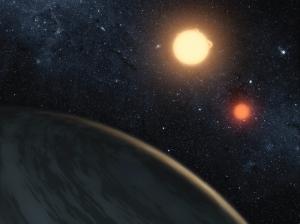
Stargazing Nights
- Where:
- Frosty Drew Observatory
- When:
- Friday April 13, 2018 at 8:00 p.m
- Cost:
- $1 Suggested Donation per Person
Tonight is Stargazing Night at Frosty Drew Observatory and forecasts are calling for partly cloudy to mostly clear skies for most of the night. There is a bit of variability in the forecast, which usually favors us. This could be potentially awesome considering we have practically no Moon tonight with the 3% waning crescent rising just before dawn. These are the nights that bring super dark skies to Frosty Drew Observatory. We’ll take the night as it goes, though we are hopeful for a great night!
We will open the Observatory and Sky Theatre at 8:00 p.m. In the Observatory, telescopes will start off with a quick view of Venus, which is becoming quite the beacon in the twilight western sky. Once twilight wanes, we will direct our telescopes towards all the amazing celestial objects visible on dark nights, including the Orion Nebula, Messier 46 open star cluster, and dozens of galaxies that rock the sky in the spring. We will also attempt our first view of Jupiter for the 2018 viewing season around 11:00 p.m. The Sky Theatre will be showing our showcase of celestial objects photographed at Frosty Drew Observatory. We’ll stay open until 11:30 p.m. unless clouds attack and shut us down first.
Overall, tonight is a tough call. Once night shy of the New Moon makes it an excellent prospect. Though we can expect the chance of periodic cloud attacks with conditions likely being more hazy than cloudy. For the purist who needs super clear dark skies, this may not be your night. But for the rest of us in desperate need of a solid astro-fix, tonight will likely be an okay night. We will also catch our first view of Jupiter tonight, kicking off a fantastic spring and summer with the planets. Don’t let today’s clouds bring you down, get out there tonight and rock the cosmos with us!
----------------------
Weekly Happenings
Scott MacNeill
On Monday, April 16, 2018, the NASA Transiting Exoplanet Survey Satellite (TESS) will launch from Cape Canaveral’s Space Launch Complex on the SpaceX Falcon 9 rocket. Tasked with succeeding the fabulous NASA Kepler mission, TESS will be the first exoplanet hunting mission that will perform an all-sky survey. Observing over 200,000 of the brightest stars in the sky, TESS will discover thousands of nearby exoplanets, with a focus on Earth-sized planets. Exoplanets are planets that orbit a star that is not the Sun and reside outside of the Solar System. Thanks to the Kepler mission, alongside other ground based telescopes, we have discovered 3,700 confirmed exoplanets and that number is on the rise. TESS will set the stage for next-gen telescopes, like the James Webb Space Telescope (JWST) to directly observe nearby exoplanets and peer into their atmospheres. Kick back on Monday evening (6:00 p.m. ET) and enjoy the launch Live on NASA TV. Catch up on the amazing things TESS has in store for us.
Have you noticed that bright, somewhat yellow, star-like object in the early morning towards the southern side of the sky? That’s not star, it’s Jupiter -the largest planet in the Solar System. With each passing night Jupiter has been rising earlier and is now rising around 9:30 p.m. This will put Jupiter viewing easily into our Stargazing Nights. Jupiter will achieve opposition on May 8, 2018. This happens when Earth and Jupiter align with the Sun where Jupiter is on the opposite side of Earth than the Sun. Consequently, this is the time that Jupiter is closest to us for our year and places Jupiter into the sky all night long. After opposition, Jupiter will be visible at sunset. Observing Jupiter in the Frosty Drew Observatory telescope will reveal the four Galilean Moons (Io, Europa, Ganymede, and Callisto), two dark equatorial bands, and the Great Red Spot - if in view. Due to Jupiter's 3.1° tilt on its axis, we often see solar eclipses happening on the massive planet. Called “shadow transits”, we observe the shadow of the Galilean Moons cross the day-lit surface of Jupiter. For those at home, the Galilean Moons are visible in small telescopes as well as binoculars. Jupiter is the first of 3 outer planets (in relation to Earth) that will be visible this spring and summer.
Today is the first of two Friday the 13ths in 2018. If that’s a problem, be safe. Otherwise, yeah Happy Friday the 13th.
-Scott


